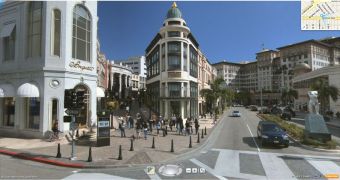A cocktail of Microsoft technologies is the catalyst for what the company has called the first big refresh of the technology behind Bing Maps in years. By mixing together not just the mapping, search and location platform, but also Photosynth, Silverlight and Seadragon, along with additional technologies from Live Labs, Microsoft Research, and even third-parties, Microsoft has given birth to Bing Maps Beta, which brings to the table a superb evolution compared to the pain vanilla Bing Maps.
Both flavors of Bing Maps continue to be accessible side by side. The old Bing Maps AJAX site is still in place, but simply adding an “explore” to the end of its URL will take users into a completely overhauled experience, the new version of Bing Maps. The Beta version of Bing Maps is built entirely in Silverlight, Microsoft’s alternative to Adobe Flash, and kicks up a notch the level of user experience offering such features as Streetside, Enhanced Bird’s Eye, the Application Gallery, integrated 1-click directions, multiple searches, etc. This is all possible only through the concert of Microsoft technologies working in synchrony.
“We’re in a unique position at Microsoft,” noted Stefan Weitz, Bing director. “Our talent in Microsoft Research, Microsoft Live Labs and our core engineering teams really combine to be more than the sum of their parts to deliver experiences that better map to what people are doing. It’s about measuring success in the real world — not just asking the user ‘Did you find the link you were looking for?’ but rather ‘Did you accomplish what you were trying to do?’”
There are five major aspects of the Bing Maps Beta evolution. The first users are bound to notice is the intimate integration between Silverlight and Bing Maps. In this regard, the Beta version of the company’s mapping platform offers users a new, enhanced, navigation model as well as a clearly superior experience. The Seadragon Deep Zoom UX is now an integral part of Bing Maps, truly serving its purpose in a Cloud app where zooming actions are at the very basis of the UX. But the evolution has also introduced smoother transitions that make it a pleasure to jump from one location on the map to another.
Silverlight also made possible Streetside. “Perhaps you’re familiar with our initial release of Streetside photography in a technology preview of Live Search Maps which launched over 2.5 years ago - now, that’s going old school. With the enhancements of Silverlight 3 we’re able to take advantage of the 3D aspects included within the platform and truly immerse users into the site,” revealed Chris Pendleton, the Bing Maps technical evangelist for Microsoft.
With Streetside now integrated into Bing Maps Beta, users will be able to get down to street level and explore neighborhoods in major cities around the world as if they were walking the streets. According to the Redmond company, Microsoft has harvested street-level imagery for approximately 100 U.S. cities, but it promised that more coverage will be added in the future.
“Enhanced Bird’s Eye – Ah, our lovely Bird’s Eye photography. There’s just something about viewing an area from the sky using the four cardinal directions. Now, this is not your grandpa’s Bird’s Eye, oh no. We had to up the ante with Silverlight 3, so there are different experiences based on whether you’re in an urban or non-urban area for Enhanced Bird’s Eye – after all, it is “enhanced”,” Pendleton added.
Microsoft is also continuing to stress that Bing Maps is much more than just a Cloud-based application, and that it is in fact a platform. This is why the new Beta release features its very own Application Gallery. “Bing Maps is now offering an application gallery for “mapplications” mashed into our consumer site. Now, to be clear we have the Bing Maps Platform for adding Bing Maps to your applications (or mashups). This is a little different – we’ve added a catalogue of applications for you to simplify your search and bookmark your favorite applications that have been built within Bing Maps,” Pendleton explained.
And of course, then, there’s the close integration of Photosynth. Microsoft has for quite some time melted the Photosynth project into the Bing Maps team, and it was clear that the technology allowing users to build 3D spaces, or synths, out of 2D imagery, would at some point support new ways for end users to explore content on Bing Maps. “If you’ve built a synth on Photosynth.com and geo-annotated it (the little globe icon) your synth gets indexed into Bing Maps. To view a synth on Bing Maps, open the app in the Application Gallery then explore where synths are available,” Pendleton promised.

 14 DAY TRIAL //
14 DAY TRIAL //